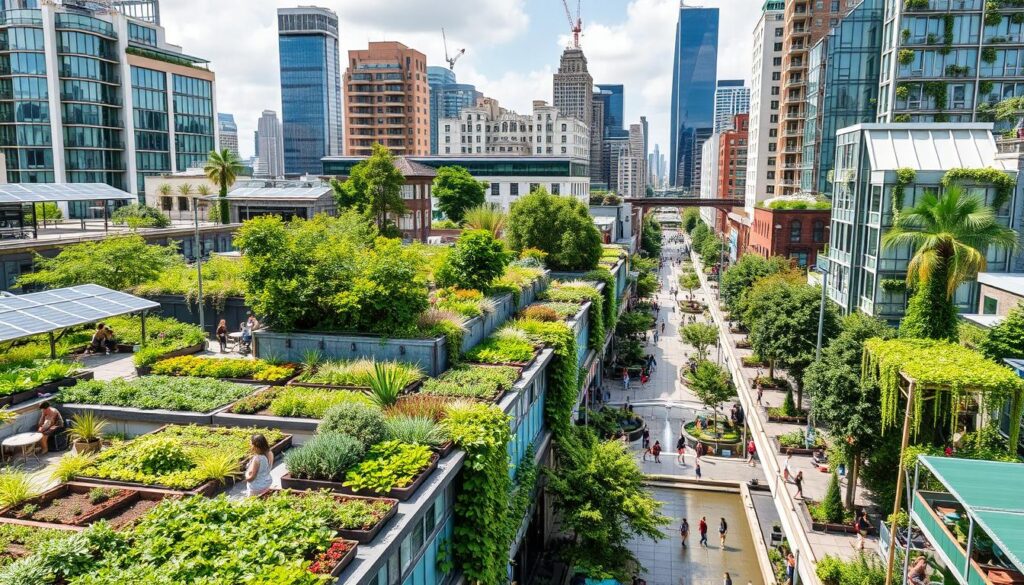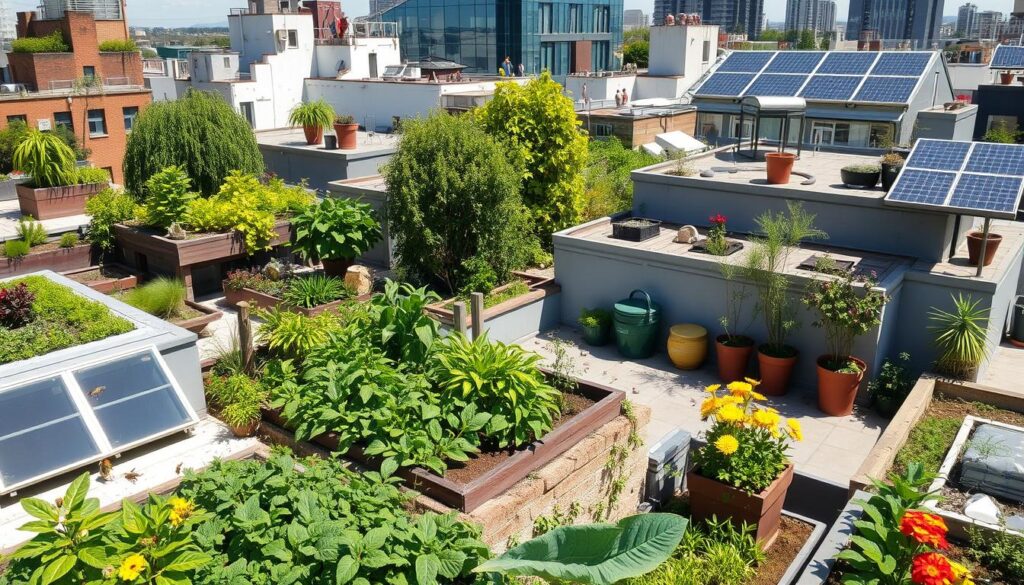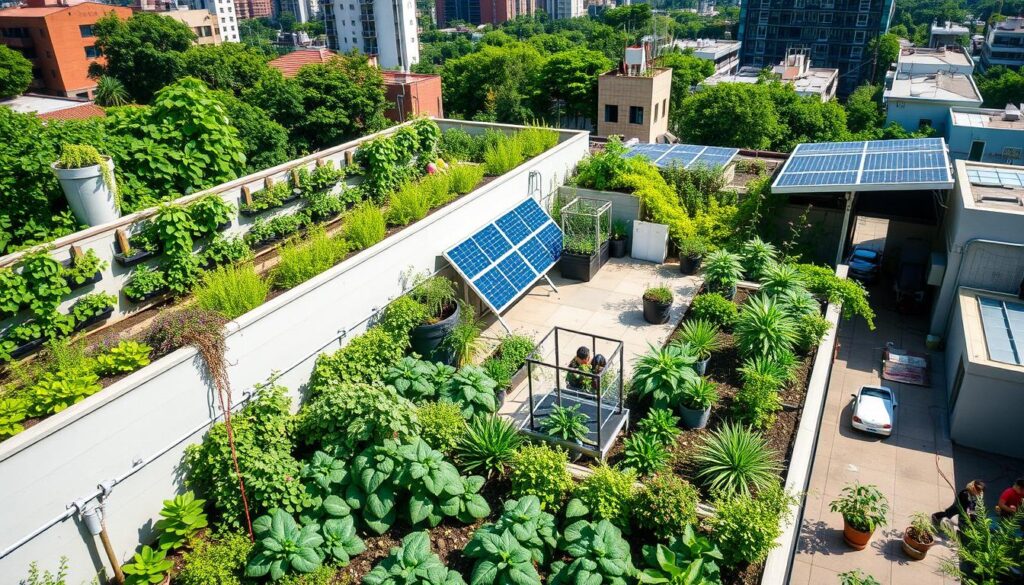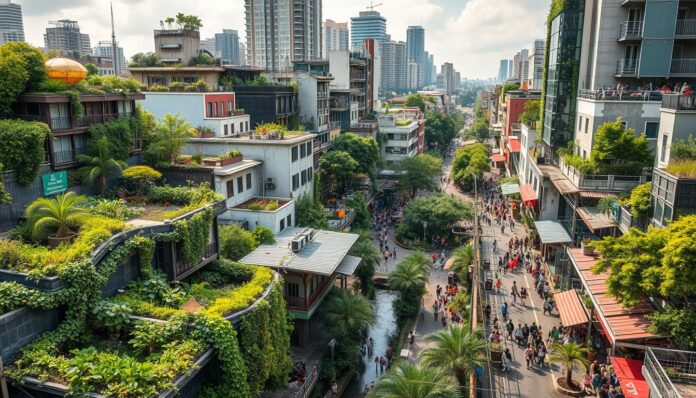As cities grow, with 50% of people living in them, we need sustainable urban planning more than ever. Permaculture design, started in the 1960s, is a key solution. It helps create cities that are green, regenerative, and work with nature. Toby Hemenway says permaculture fits well in cities, improving life for city folks.
Permaculture design aims to cut down on city energy use, like Toby Hemenway did in Portland. It also offers insights into using permaculture in cities, as shown in The Permaculture City. This approach is crucial for a greener future.
Introduction to Permaculture Metropolitan Design
Permaculture design creates systems that renew themselves, like nature. Urban planners use it to make cities sustainable and regenerative. It’s about farming in a way that’s good for the planet.
Key Takeaways
- Permaculture metropolitan design can help reduce urban energy use and create sustainable cityscapes.
- Permaculture design is beautifully suited to urban contexts and focuses on community and human relationships.
- Sustainable urban planning and green city development are essential for creating a better quality of life for urban dwellers.
- Permaculture principles can help create a low input – high output farming system, reducing the environmental impact of urban agriculture.
- Permaculture metropolitan design is an essential tool for creating a more sustainable future.
- Urban permaculture focuses less on gardening and more on community and human relationships, emphasizing the importance of social connectivity.
Understanding Permaculture in Urban Settings
Permaculture is a way to design urban spaces that are sustainable and regenerative. It helps cities lessen their environmental footprint and enhance residents’ quality of life. Key to this is eco-friendly city design and sustainable practices.
Definition of Permaculture
Permaculture is about working with nature, not against it. It aims to create systems that are self-sufficient and diverse, like natural ecosystems.
Key Principles of Permaculture
Permaculture focuses on saving water, cutting down waste, and boosting biodiversity. In cities, this means using rainwater systems, composting, and planting native plants.
Benefits of Permaculture Design
Permaculture design in cities offers many benefits. Some include:
- Improved air and water quality
- Increased biodiversity
- Reduced environmental impact
- Enhanced community engagement and social cohesion
By using permaculture in urban design, cities can foster sustainable ecosystems. These ecosystems benefit both people and the environment.
| Benefits | Description |
|---|---|
| Improved Air Quality | Reduced pollution through green spaces and urban forestry |
| Increased Biodiversity | Promotion of native plant and animal species |
| Reduced Environmental Impact | Conservation of water and reduction of waste |
The Importance of Metropolitan Design
Metropolitan design is key to making cities better and more livable. It covers urban planning, architecture, and landscape design. It helps solve problems like pollution, traffic jams, and unfairness.
Urban planning is a big part of this. It makes cities greener and improves life for people living there. It’s about making cities good for the environment, fair for everyone, and strong economically. Also, green city development is important. It aims to make cities sustainable and strong against disasters.

Definition of Metropolitan Design
Metropolitan design brings together architects, planners, and others. They work together to make cities work well, look good, and be efficient.
Role of Urban Planning in Sustainability
Urban planning is crucial for a green city. It designs cities that are small, connected, and strong. This helps cut down on pollution, saves resources, and boosts health.
Challenges in Urban Environments
Urban areas face big problems like pollution, traffic, and unfairness. Good metropolitan design tackles these by making cities green, fair, and strong. Ways to do this include:
- Adding green spaces like parks and roofs
- Supporting walking and cycling
- Encouraging buildings that serve many uses
By using these methods, cities can become better places to live. They offer a great quality of life for their people.
Integrating Permaculture into Urban Landscapes
Urban areas can greatly benefit from permaculture principles. These aim to create biodiverse urban environments through sustainable design and practices. By using urban agroecology and green infrastructure design, cities can improve their ecological footprint. This also enhances the quality of life for their inhabitants.
One key technique is using vertical gardens and green roofs. These not only provide habitat for wildlife but also reduce stormwater runoff and improve air quality. Community gardens also play a role, promoting social cohesion and community engagement.
Techniques for Urban Integration
Effective techniques for urban integration include:
- Vertical gardens and green roofs
- Community gardens and urban agriculture
- Green infrastructure design and planning
These approaches help create biodiverse urban environments. They promote sustainable living in urban areas.
Vertical Gardens and Green Roofs
Vertical gardens and green roofs are innovative ways to incorporate urban agroecology into urban landscapes. They increase urban green space, reduce urban heat islands, and improve air quality. By adopting these techniques, cities can become more sustainable and resilient.
Community Gardens as a Model
Community gardens serve as a model for urban agriculture. They show the potential of green infrastructure design to promote social cohesion and community engagement. By providing a space for people to grow their own food, community gardens help build stronger, more sustainable communities.
Case Studies of Successful Urban Permaculture
Urban permaculture has been a hit in many U.S. cities. It shows how permaculture can make cities sustainable and regenerative. The Beacon Food Forest in Seattle is a great example of this.
Notable Examples Across the U.S.
The Sherrett Food Forest in Portland is another success story. It shows how important sustainable urban planning is. These projects prove that permaculture can turn cities into green, thriving places.
Analyzing Impact and Results
Looking at these projects’ results, we learn a lot. We see how permaculture can boost biodiversity and air quality. It also brings people together.
Lessons Learned from Successful Projects
Key takeaways include the value of community and sustainable planning. Permaculture can make cities strong and green. By using these lessons, cities can improve for everyone and the planet.

Designing for Biodiversity in Cities
Creating biodiverse urban environments is key for healthy ecosystems. Urban agroecology and green infrastructure design help achieve this. By using native plants and reducing pollution, cities can boost biodiversity and ecosystem health.
Strategies for enhancing urban biodiversity include:
- Using native plants to maintain ecosystem services
- Creating habitat for wildlife, such as birds and insects
- Reducing urban pollution through green infrastructure design
Urban agroecology is vital in designing biodiverse urban environments. By applying green infrastructure design, cities can build sustainable ecosystems. This not only helps the environment but also improves urban residents’ well-being.
To design for biodiversity in cities, we need a holistic approach. This includes urban agroecology and green infrastructure design. Together, we can create thriving, biodiverse urban environments that support both people and the planet.
| Strategy | Benefits |
|---|---|
| Using native plants | Maintains ecosystem services, supports local wildlife |
| Creating habitat for wildlife | Enhances biodiversity, supports urban ecosystem health |
| Reducing urban pollution | Improves air and water quality, supports human health |
Water Management in Metropolitan Permaculture
Effective water management is key in permaculture metropolitan design. It makes urban ecosystems more sustainable and resilient. Using sustainable urban planning like rainwater harvesting and greywater systems helps a lot. It cuts down on stormwater runoff and saves water.
This is vital for green city development. It helps cool down cities and improves air quality.
In cities, managing water can be done in many ways. For example:
- Rainwater harvesting systems collect and store rainwater for uses other than drinking.
- Greywater systems use wastewater from sinks, showers, and washing machines for irrigation and flushing toilets.
- Green infrastructure, like green roofs and urban wetlands, filters and manages stormwater runoff.
By using these methods in permaculture metropolitan design, cities can lessen their environmental impact. This leads to more sustainable urban planning. It also supports green city projects, focusing on people’s health and the environment’s well-being.
Soil Health and Urban Agriculture
Urban agriculture is key in solving food shortages, heat islands, and green space needs in cities. Urban agroecology is vital for healthy soils and sustainable food. It helps cities create biodiverse urban environments with many plant and animal species.
Improving soil health in urban farming includes:
- Composting and organic waste management
- Soil testing and remediation
- Use of cover crops and crop rotation
These methods boost soil fertility, cut down on contamination, and raise crop yields.
Urban farming methods like vertical and container gardening increase food production in cities. By using empty lots and buildings, urban farming turns unused space into food areas. This can boost food access by 30% in cities.

Boosting soil health and urban farming is crucial for sustainable and biodiverse urban environments. By using urban agroecology and green infrastructure design in city planning, we can tackle big environmental and social issues.
| Urban Agriculture Strategy | Benefits |
|---|---|
| Composting and organic waste management | Improves soil fertility, reduces waste |
| Soil testing and remediation | Identifies and addresses soil contamination |
| Use of cover crops and crop rotation | Improves soil health, increases crop yields |
Energy Efficiency in Urban Permaculture
Energy efficiency is key in urban permaculture. It helps cut down energy use and greenhouse gas emissions. By using permaculture design, cities can become greener and more sustainable.
Sustainable urban planning is essential. It means designing cities with green development in mind. This makes cities better for the environment.
Some important strategies for energy efficiency include using renewable energy. This includes solar and wind power. It also means designing buildings to use less energy.
Renewable Energy Options
Renewable energy is vital for energy efficiency in urban permaculture. It includes solar, wind, and geothermal energy. Using these sources helps cities use less fossil fuels and cut carbon emissions.
The Role of Energy in Design
Energy plays a big role in design. It helps reduce energy use and improve efficiency. Designing buildings and cities with energy in mind is crucial.
By using energy-efficient design and renewable energy, cities can become greener. This benefits the environment and improves life for city residents.
| Energy Efficiency Strategy | Benefits |
|---|---|
| Renewable Energy Options | Reduced greenhouse gas emissions, lower energy costs |
| Energy-Efficient Design | Reduced energy consumption, improved indoor air quality |
Community Engagement in Permaculture Projects
Community engagement is key for permaculture projects to succeed. It builds a supportive network and promotes community ownership. Through outreach and education, urban agroecology initiatives can grow. They create biodiverse urban environments that help both people and the planet.
Green infrastructure design is vital in community-led initiatives. It helps create sustainable and resilient urban ecosystems. By applying permaculture principles in urban planning, cities become more livable. Green spaces beautify the environment and improve community well-being.
Importance of Community Involvement
Community involvement is crucial for permaculture projects. It ensures local residents’ needs and concerns are considered. By working with the community, permaculture practitioners can design projects that meet the area’s specific needs. This creates biodiverse urban environments that are sustainable and fair.
Strategies to Encourage Participation
To get more people involved, permaculture practitioners can use several strategies. These include outreach, education, workshops, training sessions, and volunteer opportunities. By offering chances for community members to participate, projects can foster a sense of ownership and responsibility. This ensures their long-term success.
- Community outreach and education
- Workshops and training sessions
- Volunteer opportunities
Together, community members and permaculture practitioners can create thriving, biodiverse urban environments. These environments promote sustainability, equity, and community well-being. They use green infrastructure design and urban agroecology principles.
Design Elements of a Permaculture Garden
Permaculture design and sustainable planning are key for green cities. They help bring biodiversity and health to urban areas. A good permaculture garden uses many elements to thrive.
By using permaculture, people can make their cities green and strong. Permaculture practice shows zones and sectors are vital. They help manage the garden. Combinations of plants and animals make the garden diverse and strong. Microclimates boost biodiversity and cut down on outside help.
- Zone 1: Close access for daily use, herb and vegetable gardens
- Zone 2: Food Forest with fruit and nut trees, chickens, and beehives
- Zone 3: Area farmed by local farmers
- Zones 4 and 5: Minimal access for firewood collection, foraging, or left wild
These zones help make a self-sustaining garden. They support permaculture design and green cities. By using these elements, people can make their gardens thrive. This helps create a better future for all.
Policy and Permaculture in Urban Design
Urban policy trends are key in using permaculture in city planning. By supporting permaculture-friendly policies, cities can foster sustainable growth. Urban agroecology and green infrastructure design are crucial. They help make cities more biodiverse and healthy.
Permaculture in urban design brings many benefits. It reduces waste and boosts energy efficiency. For instance, green buildings can save up to 50% on energy each year. Also, urban agroecology can cut water use by half through smart water systems.
Cities can adopt permaculture in their planning. This includes starting community gardens, green roofs, and urban forestry programs. Working with local governments and groups, cities can become more sustainable and strong.
Projects like the Incredible Edible Todmorden in the UK and the Beacon Food Forest in Seattle show permaculture’s power. They show how permaculture can change urban areas and encourage green living.
| Project | Location | Benefits |
|---|---|---|
| Incredible Edible Todmorden | Todmorden, UK | Increased food access, community engagement |
| Beacon Food Forest | Seattle, USA | Enhanced biodiversity, community education |
The Future of Permaculture in Urban Areas
As cities grow, the need for sustainable urban planning and green city development grows too. Permaculture metropolitan design is a key solution. It combines food production, renewable energy, and water management for self-sufficient cities.
Some important strategies include:
- Vertical gardening and urban agriculture to boost food and reduce harm to the environment
- Rainwater and greywater systems to cut down water use
- Creating green spaces and natural areas to boost biodiversity and health
By using these strategies, cities can become more sustainable and better places to live. Technology is also crucial, helping make cities greener and more resilient.
Looking ahead, sustainable urban planning and green city development are key to a better world. By adopting permaculture metropolitan design, we can build cities that thrive and are good for the planet.
| Strategy | Benefits |
|---|---|
| Vertical gardening and urban agriculture | More food, less harm to the environment |
| Rainwater harvesting and greywater systems | Less water use, more efficient |
| Green spaces and natural ecosystems | Better biodiversity, healthier ecosystems |
Getting Started with Metropolitan Permaculture
Starting a sustainable urban future needs a big plan. It must include permaculture principles in city design. Urban planners should first look at the local ecosystem.
They should find chances for urban agroecology and green infrastructure design. It’s also key to work with the community. This way, cities can become healthier and more resilient.
For more learning, there are online courses, books, and local permaculture groups. These help urban planners and community members learn and grow. They share ideas and support each other in making cities better.
The success of metropolitan permaculture depends on those who act and lead. By using a holistic approach to city design, we can build strong, vibrant cities. These cities will meet the needs of their people in many ways.

